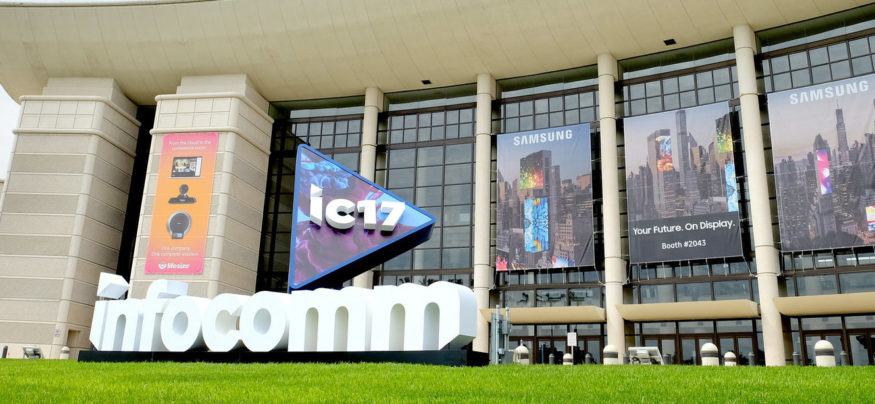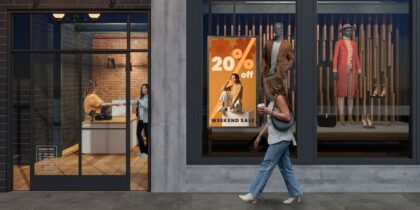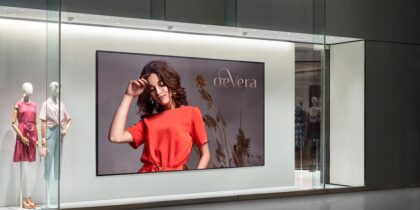Anyone walking around this year’s InfoComm show in Orlando would conclude, very quickly, that just about any surface can — and will — be a canvas for digital visuals.
The annual pro AV show has approximately 1,000 exhibitors showing off technologies designed to either display visuals and transmit sound, or provide the infrastructure to make that happen. There are massive booths from major manufacturers advertising the latest displays, to the smaller businesses at the back of the hall with the cables and connectors that bring projects to life. It’s also a great one-stop forum to pick up on digital signage trends.
It’s evident that Narrow Pixel Pitch LED displays are going to be a big part of how architects, designers and systems integrators will fill big spaces. The directly viewed LED displays allow designers to fill vertical surfaces — like the feature walls of big stores and the lobbies of offices and hospitals — with visuals that hit any necessary dimension and scale.
Build the Optimal Videowall for Your Business
Download this white paper for a free guide to video wall solutions. Download Now
Even three years ago at InfoComm, there were just a handful of companies showing LED displays with pixel pitches — the distance between LEDs — of less than 2.5 mm. At InfoComm 2017, there are dozens, and the pitch is as tight as 0.7 mm for some manufacturers.
When this technology first emerged, the vendors tended to be small, little-known companies. These days, companies like Samsung have also added Narrow Pixel Pitch to its display roster, with Smart LED versions as small as 1.5 mm. While the technology is intended mainly for walls, there are companies showing hardened displays that can be used as floor surfaces, and manufacturers are starting to show ways to support touch interaction on LED.
Getting Into the Pixels
The other display technology that has turned heads in recent years is OLED, and most recently, Quantum Dots LED, or QLED. The technologies are very different, but visual impact they seek to achieve is similar: Vivid, premium visual experiences for high-end digital signage applications like luxury retail and museums.
OLED is marketed based on its ability to deliver true black, or the absence of color, because the technology allows each individual pixel to be illuminated or turned off. But the commercial versions have had some of the same image retention (or burn-in) issues that plasma displays had.
Samsung’s QLED is effectively a premium LCD display with a quantum dots layer that optimizes the visuals and provides true color, regardless of the brightness. It also provides all the long operating life and reliability properties of regular premium display panels.
Real-Time Data Integration
Several education sessions built around relating major digital signage projects that used LCD and LED video walls explored the fast-emerging use of real-time data to create and drive content. One application came from the AT&T’s flagship store in San Francisco, where a huge video wall’s content is all computer-generated, based on the store audio and data from sensors. The template was designed once, and the visuals change constantly, with no additional creative work needed. This helps address the challenge of keeping digital signage screens consistently populated with fresh content.
The technology that drives content is also changing. While some InfoComm show vendors were showing video wall servers the size of small refrigerators, there were others offering digital signage PCs about the size of a lemon.
Numerous display companies have followed Samsung and introduced “smart” displays with embedded media players, removing the cost and reliability issues of external players. Samsung’s Smart Signage Platform team was previewing the fifth generation of its program, with the newest system-on-chip-equipped displays running Tizen 3.0.
The InfoComm show this year drew around 40,000, and it’s clear that the digital signage industry is moving in a direction that signals smarter, lighter and longer-lasting displays coming to the market over the next few years.
The 2018 edition returns to Las Vegas. If you are in the pro AV or digital signage business, it’s definitely somewhere you’ll want to be.
Digital signage can provide a new level of customer interaction and engagement for your enterprise.









